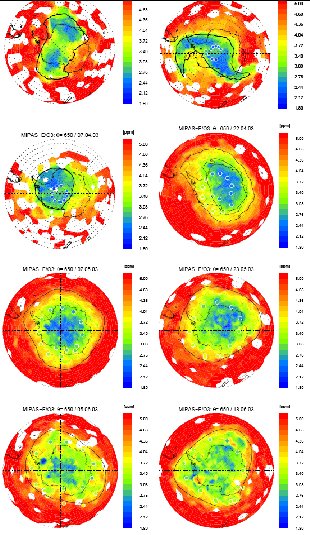The Origin of the Hole in the Ozone Layer: Jülich Discovers Barriers
Researchers explain the processes involved in the formation of the ozone hole
[20. Dezember 2006]
Jülich, 20. December 2006 - Atmospheric researchers at Jülich have discovered a phenomenon that makes a significant contribution to the ozone hole in the early stages. In the polar vortex - this is where the ozone hole occurs above the Antarctic every winter - a double transport barrier is created. It prevents the exchange of air between the ozone-rich surrounding air and the ozone-poor layer inside the vortex. Nitrogen also plays an important role in this phenomenon. (Development of tracer relations and chemical ozone loss during the setup phase of the polar vortex, S. Tilmes et al., Journal of Geophysical Research, Vol 111)
"The future of the hole in the ozone layer can be reliably predicated with the aid of climate models only when processes such as the formation of the ozone hole are fully understood", explains Simone Tilmes, former scientific data analyst at Research Centre Jülich who is now conducting research at the renowned National Center for Atmospheric Research in Boulder, USA, supported by the German Academy of Sciences Leopoldina.
In winter, the well-known ozone hole in the stratosphere over the Antarctic grows. This is where the so-called polar vortex moves in a circular motion at a height of approx. 20 km during the winter months. In this extremely cold air mass, isolated from the surrounding environment by strong wind flows, a large area of the ozone layer is destroyed every winter.
"The finger has always been pointed at humankind and their use of chlorine compounds as the cause of the ozone hole in the stratosphere", says Dr. Rolf Müller from Research Centre Jülich. "However, up until now, we didn't know very much about what was happening during autum in the Antarctic stratosphere before the ozone hole forms", the atmospheric researcher emphasises.
For the first time, a Japanese satellite experiment (ADEOS-II/ILAS-II: Advanced Earth Observing Satellite/ Improved Limb Atmospheric Spectrometer) has now made data available which will allow us to learn more about the early stages involved in the formation of the ozone hole. Scientists at Jülich together with their Japanese colleagues have succeeded in showing that air inside the polar vortex, even during vortex formation, is much more heavily shielded from the surrounding air layers than was previously assumed.
The scientists discovered a double "transport barrier" at the edge of and inside the polar vortex which ensures that there is no exchange between the polar vortex and the surrounding air masses. This causes ozone depletion to occur in early winter: naturally occurring nitrogen found in the stratosphere begins to deplete ozone at this early stage. The barrier in the polar vortex ensures that the now ozone-poor air does not mix with the ozone-rich air masses outside the vortex. The sinking temperatures in the polar vortex cause ice clouds to form, in which ozone depletion occurs because of chlorine radicals. The hole in the ozone layer is formed.
A trend has become clear: "the stratosphere cools down more and more and new low-temperature records are broken over and over in the polar vortex", notes Rolf Müller. This means that the polar vortex becomes more stable and the exchange between ozone-rich and ozone-poor air masses diminishes. Whether climate change can be felt here yet or not is an issue that remains to be resolved.

Ozone distribution (in ppm) in the polar vortex (black circle) above the Antarctic and in the surrounding air, from March (above left) to June 2003 (bottom right). From measurements taken by MIPAS Instruments on the ESA satellite Envisat
German Version
Contact:
Annette Stettien, Barbara Schunk
Science Journalists
Research Centre Jülich
52425 Jülich, Germany
Tel. +49 2461 61-2388, Fax +49 2461 61-4666
E-Mail: a.stettien@fz-juelich.de, b.schunk@fz-juelich.de
Dr. Angela Lindner
Head Public Relations and Press Relations Officer
Tel. +49 2461 61-4661
E-Mail: a.lindner@fz-juelich.de


